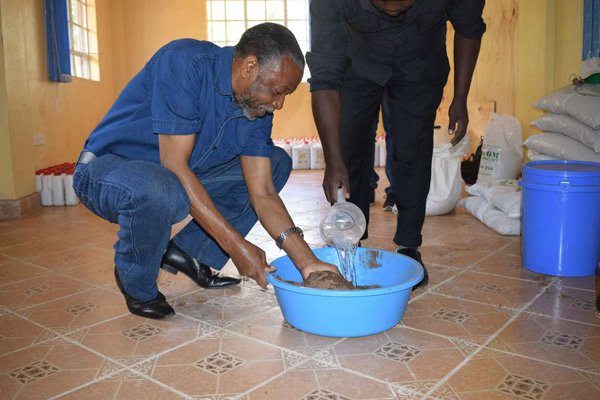Two men at a store in Dandora, Nairobi, unload sacks of water hyacinth from a waiting pick up. Simon Njoroge, wearing a white lab coat and gumboots, looks on as the cargo is removed from the vehicle into a room.
The hyacinth is later placed in a machine that crushes it, separating liquid from solid matter in a few seconds. Njoroge is in the process of making fertilizer from the much dreaded plant that has colonized Lake Victoria.
“Using the machine, I can extract liquid and solid fertiliser from water hyacinth. This plant is gold,” says Njoroge, who adds other minerals like calcium and potassium on the extract to come up with a well-balanced fertiliser.
It takes about five minutes to get a liquid fertiliser and a solid residue rich in protein, carbohydrates and fibre.
“I use what I call organic synthesis, a process which builds molecules ranging from complex, biologically active natural products to new materials,” he explains.
He says the process completely changes the nature of hyacinth, ensuring its seeds are killed and cannot multiply.
“The fertilizer I make is determined by its purpose and where it will be applied. This is because the soil composition in various region differ.”
The biochemistry scientist says he began his research in 1996 when retired President Daniel arap Moi decried an increase of water hyacinth in Lake Victoria.
“He issued a statement seeking for a solution to eradicate the plant. This motivated me to research on the plant,” he says.
His research revealed that the hyacinth is rich in nutrients that are useful to plants and livestock.
DOES NOT ACIDIFY SOIL
“I realised we could derive several nutrients from the plants, and I assembled a machine that helps to separate liquid from the plant tissue,” he says, adding he took his NPK-based fertiliser to the then Kenya Agricultural Research Institute for testing and was found to be good for use.
In 1999, he applied for a patent with World Intellectual Property Organisation (Wipo). The application was later allowed in 2004 after a thorough examination.
Wipo website shows that he uses a method that comprises of placing the aquatic plants together with sufficient water in a tank, and blending the mixture to finely divide the plant matter, which is then mixed with an aqueous solution containing alkali salts to dissolve nutrients such as nitrogen, phosphorus and potassium.
He ventured into mass production in 2004 after a foreign company funded his idea under his HyaQuip Inc Company.
The machine that he came up with has a capacity to crush 250kg of the plant in about five minutes, in total producing at least 10 tonnes in eight hours daily.
The liquid fertiliser is packed in five litre containers that retail at Sh1,150 and the granular goes at Sh100 per kilo.
“Water hyacinth has natural glue that helps bind its particles together, which gives organic fertilisers the soil conditioning property. It has the capacity to convert sandy soils into loamy soils helping reclaim desert land,” he says, adding the fertiliser also helps improve the soil water retention capacity.
To plant trees in a desert area using the fertiliser, Dr Njoroge recommends that one mixes 5kg of liquid fertiliser with 200 litres of water. After watering, the trees can go for up to three months without requiring more water.
Rebecca Njuguna, a farmer in Murang’a, who has used the fertiliser says it does not acidify the soil.
Source; Daily Nation








